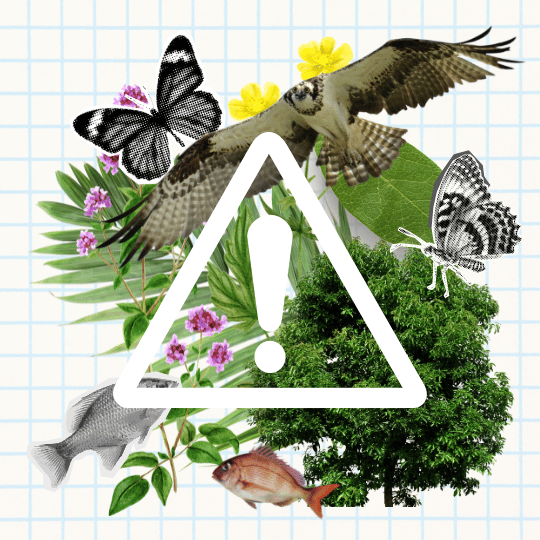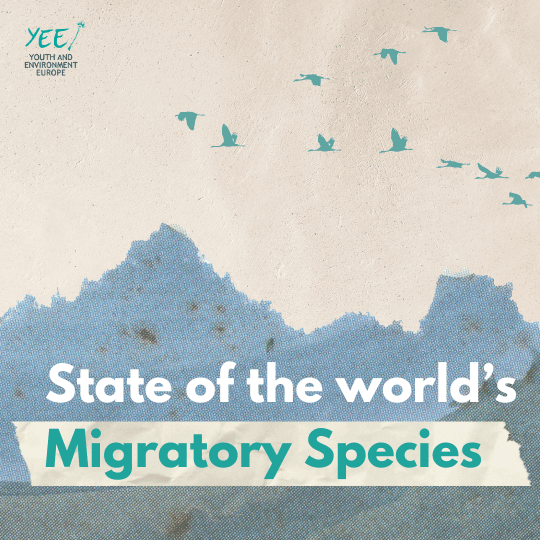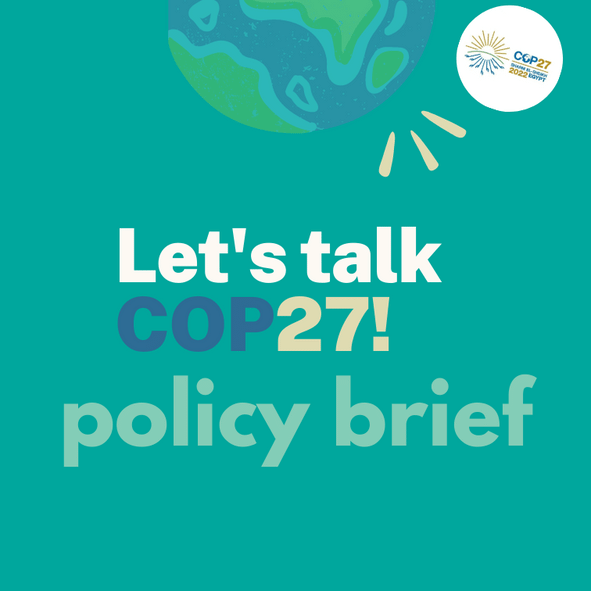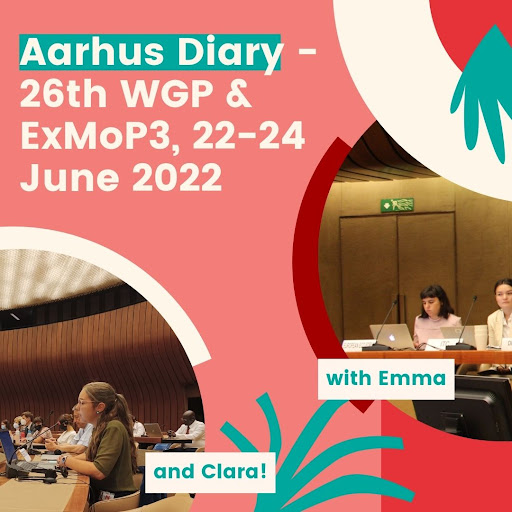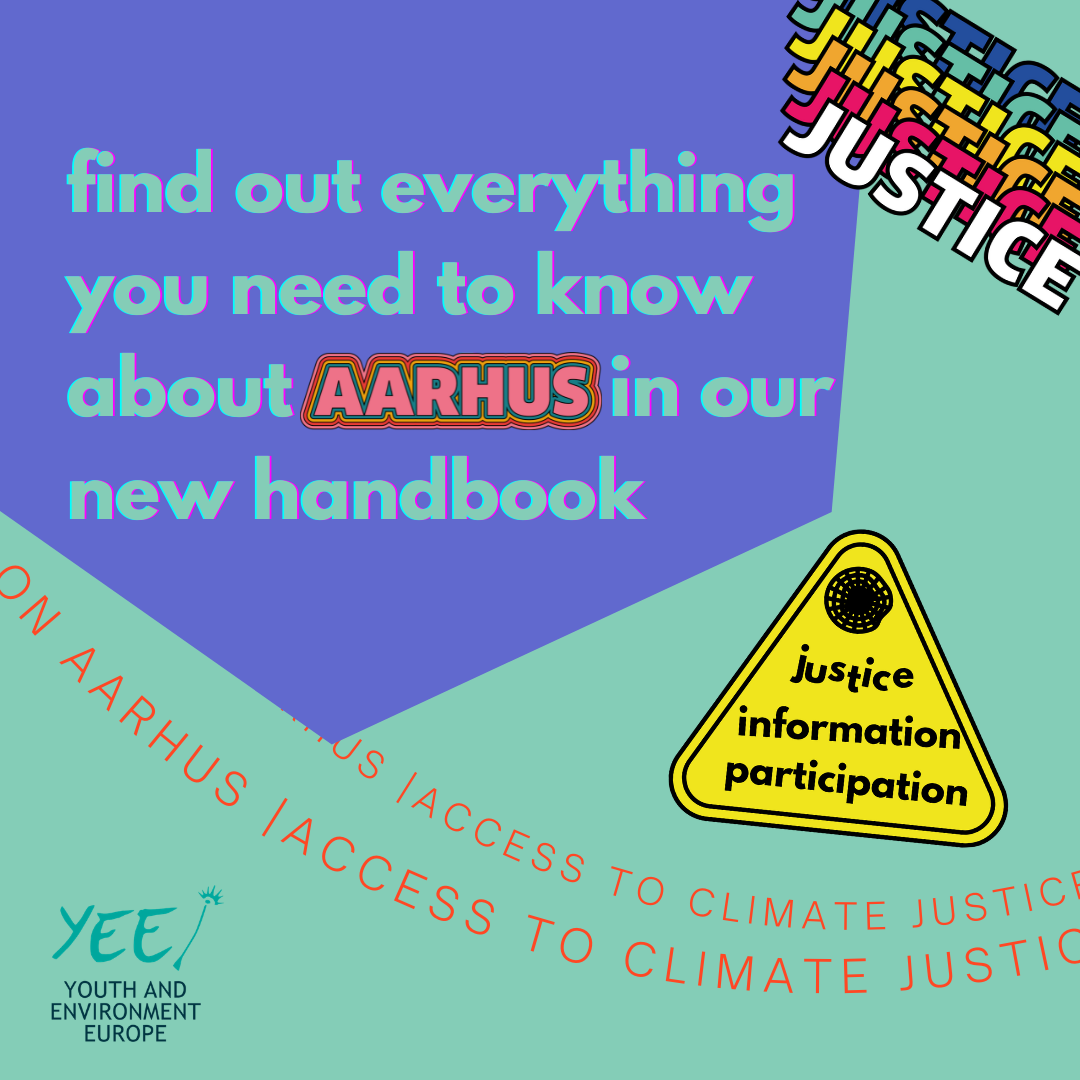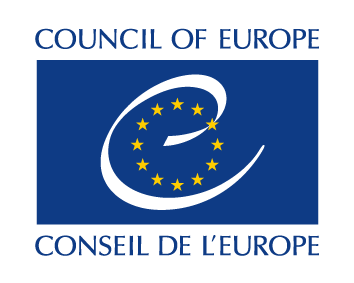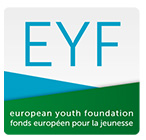In the beginning, I was all alone
Vika Hovsepyan from Yeghvard, Armenia is passionate about creating positive change in her community. She began by initiating a recycling campaign at her school and now is involved in educational projects related to the environment. Her work is motivated by seeing the positive results and the support of others. Vika’s future goal is to collect and recycle clothes to help those in need.





Tell us a bit about yourself. Who’s Vika?
I am Vika Hovsepyan from Yeghvard, which is a small town near the capital of Yerevan in Armenia. I’m 19. Since high school, I’ve tried to be active in my community and create something positive for others who have fewer opportunities or need help. I have been doing different kinds of activities in my community for more than five years now.
What is your work and how did it all start?
Around me, there were some problems which were visible and I couldn’t sit and just see what was happening near me. Everything started when I decided to create a little campaign at school involving some others who were interested. The aim was to collect paper and plastic waste and transfer it to a recycling center every three months. The reimbursement from our recycled items would be invested in the school to be used to buy some new plants, as well as for the school garden and sorting bins for waste or whatever else was needed. This became a tradition in a very short time.
I just wanted to share my ideas with the students and teachers. I started to collect all the papers because the school was full of paper and there isn’t one day that paper isn’t used. I started to collect it and then I made a small pocket where I put them away, and the students saw my steps and they followed me. This is when the project became larger.
I started on a very large scale. Students and teachers became part of this project and they supported me and encouraged me. I got support and I became very motivated, even more motivated than at the beginning. I continued with new encouragement and new motivation.
I graduated two years ago but this tradition still goes on. After that I started to participate in environmental projects to deepen my knowledge about environmental topics and my behavior has changed a lot. New eco-friendly practices were formed in my everyday life. I started to use eco bags and water bottles and now I can’t imagine my life without these steps.
What projects do you work on at the moment?
I’m part of the educational projects at Yeghvard NGO, where I’m a member and a volunteer. They organize educational projects for youth about the environment. I organise seminars and trainings for youth with fewer opportunities. There are also times when I am the participant and I strive to deepen my knowledge to be able to share it with others.
What does your work mean to you?
My work is very important for me because I started the project at school and I like seeing the good results and the happy faces of people and their reactions and support. That gives me a lot of motivation to continue what I’m doing. My vision is for people to become more careful and more caring because nature is in danger.
What’s next for you?
I want to continue my work by collecting clothes. Every year I collect clothes from people and just give them to those who have fewer opportunities and need them. In a few months, I will start and collect clothes that I will recycle. I want to open a second-hand store or engage people who have fewer opportunities than I had.
If you could send a message to other young people, what would it be?
“Whatever you do, do it for a positive result and do it with all your heart.”
This is the key to success.
It is very easy if you are motivated and want to bring change. There are only a few things you need to do. Have an aim, motivation for any situation and a strong will. This is the key because if you are not motivated if you don’t want to see a good result, if you don’t want to see happy faces, support, and change around you, nothing will change. You are the change. You will become the change and people will follow you.
Other interviews
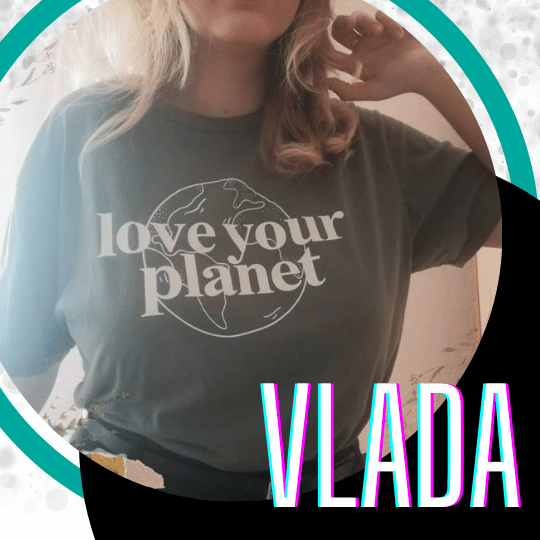
Introducing Vladislava | Showcasing the Unheard
Meet Vlada, an 18 years old activist from St. Petersburg, Russia. Vlada coordinates Fridays for Future Russia and is especially interested in the melting of permafrost in Russia, the fate of indigenous peoples, ecofeminism, food security, and a just transition. She studies ecology at a Russian state university and dreams of doing a master’s degree on climate change in Europe, as this subject is not available anywhere in Russia.
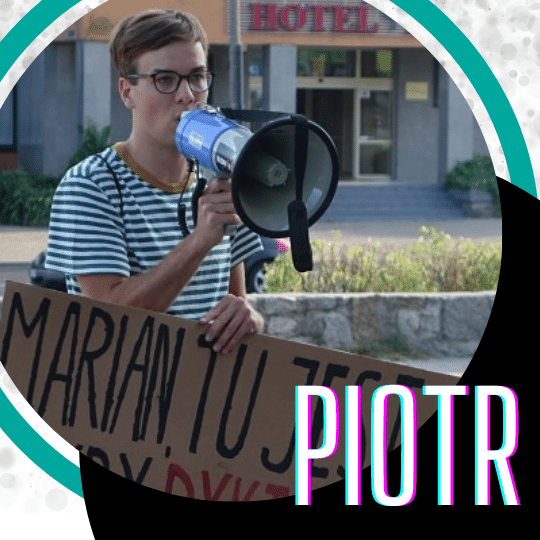
You will have new roads, but nobody to drive on them | Piotr Czerniejewski
Meet Piotr Czerniejewski, a Polish Youth and Climate Activist who is actively involved in the Just Transition process of his local area and has been promoting the inclusion of young people.
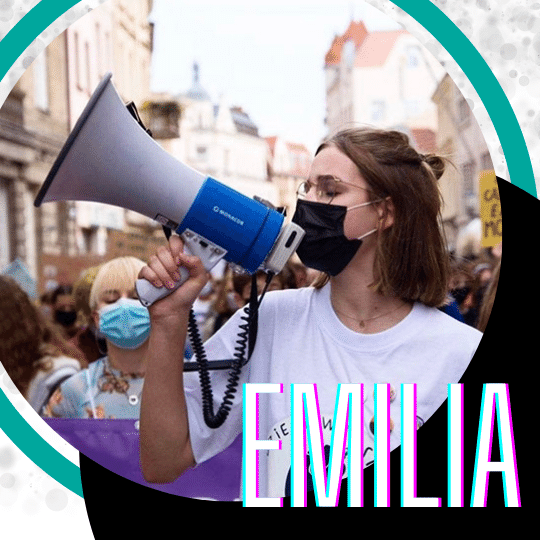
We need to make climate education a reality | Emilia Rygielska
Emilia is a 17 years-old activist and climate educator from Poland. In the following article, she talks about her experience with teaching kids about the climate crisis and why she thinks that politicians stand in the way of change.

Make at least one small eco change in your life | Ola Czajkowska
Social media on environmental issues can sometimes be the only source of knowledge for young Poles. Ola Czajkowska, a 26-year-old resident of Warsaw, has taken matters into her own hands.

#YEEinterview: Souji
Have you ever wondered what to do with the used vegetable oil that is left
Introducing Vika | Showcasing the Unheard
https://yeenet.eu/wp-content/uploads/2023/10/Vika.png 675 675 YEE https://yeenet.eu/wp-content/uploads/2018/11/logo-yee-728x1030.png YEE2023-09-02 16:26:092023-10-02 16:31:21Introducing Vika | Showcasing the UnheardExploring the biological and ecological importance of Europe’s First Wild River National Park
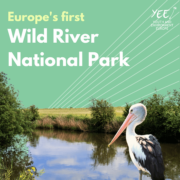
Written by

Heather Needham

Sophia Ullrich
Contents
Visual summary













Share this article
The Vjosa River
In the Pindus mountains of Greece, close to the village of Vovousa, you can find the source of the last wild river of Europe – the Aoös/Vjosa river. Flowing northwest in natural meanders, it is joined by the river Voidomatis and eventually enters Albania, where it is again joined by the river Sarantaporos. Continuing its way northwest, passing the cities Përmet, Këlcyre and Tepelenë the river is joined by its Albanian tributaries Drin and Shushicë and finally flows into the Adriatic Sea close to the well-known city Vlorë.
As a result of major undisturbed natural processes, a unique landscape and ecosystem developed over thousands of years along the course of the river, based on different flow velocities and river depths ranging from unvegetated gravel bars to floodplain forests. Local people have found a way to live in harmony with this precious ecosystem, making use of and depending on its natural resources without posing a threat to its further existence. This also allows the continued existence of a vast variety of plant as well as animal species, native to the unique and rare habitats of the river. Flagship species that have been picked up by international media representing the unique flora and fauna are the Egyptian vulture, European eel and the Dalmatian pelican, just to name a few.
Europe’s First Wild River National Park
On march 15, 2023, the precious landscape around the last free-flowing wild river of Europe was announced as the Vjosa Wild River National Park. The protection status corresponds to IUCN’s Protected Area Management Category II, the main objective being the protection of its natural biodiversity and the underlying ecological structures and undisturbed natural processes. The protection and therefore continued existence of the ecosystem also aim at the promotion of education and recreational activities.
The process and fight for the protection of the Vjosa to be declared a protected area or National park started in the year 2014 when the german magazine “Der Spiegel” published an article on the situation of rivers in the Balkan region and their threatened status due to several planned hydropower plants. After the first biodiversity assessment was carried out, underlining the unique nature of the river ecosystem, the matter attracted the attention of the European Parliament which demanded the halt for all construction plans and the control of Albania’s hydropower development. Several international protests followed, a lawsuit was filed in December 2016 to stop the development of a new hydropower project which was decided in favour of the Albanian NGO EcoAlbania. In spite of this development, the Albanian government decided to move ahead with the construction of yet another dam, triggering further protests. In 2018, data gathered by international scientists was published in the form of a study. The campaign picked up speed with yet another study by the Austrian University of Natural Resources and Life Sciences, concluding the Vjosa river to be unsuitable for energy production due to its high sediment transport. The international attention was followed by a petition, signed by 776 scientists from 46 countries in the beginning of 2020. Within the same year, the plans for the Kalicaç Dam were brought to a halt by the Albanian Environmental Ministry.
The first official proposal for the creation of a Vjosa National Park was put forward in early 2021 by 20 Albanian Environmental organisations, which was then backed up by a study conducted by the IUCN. In parallel to support by the community of scientists, public attention was further achieved by the release of an explanatory video by Patagonia as well as a significant action on World Water Day 2021 in several European cities.Throughout the year 2021, further gathering of scientific data on the Vjosa tributaries, publicity-boosting actions and the launch of a global petition were the last steps of the campaign, before it was declared a Nature Park in January 2022. However, with the status of a Nature Park not guaranteeing effective protection of the Vjosa and its tributaries and sufficient eco-touristic opportunities for the local people, the Vjosa river was finally declared a Wild River National Park ten months later, in March 2023.
A biodiversity hotspot
The rare and unique geological features of the river give rise to an equally unique diversity in plant and animal species, many of which are globally threatened and some of which are protected. As part of the mediterranean basin, the balkan peninsula is one of the 25 most important world hotspot areas of biodiversity.
In a baseline survey Scientists from all over Europe clearly presented the impact the construction of hydropower plants would have on rare habitats and therefore species, threatening the continued existence of such a unique ecosystem. The absence of fish barriers in the Vjosa, until today, allows for the existence of numerous endangered and endemic fish species that are heavily dependent on the free-flowing nature of rivers, such as the migratory European eel, which is classified as critically endangered on the IUCN Red list. Based on the variety of different habitats, a number of 18 species were found in the baseline survey, once again underlining the importance of river-connectivity and varying speed of water flow.
Within the group of Macroinvertebrates, which includes different organism groups like molluscs, worms, crustaceans, and insects, a number of 227 aquatic invertebrate taxa were found along the course of the Vjosa, some of which are still to be included in scientific research. While some of the species used to be present throughout Europe, other species like the stonefly Isoperla vjosae have, to date, been found exclusively in the Vjosa.
However, the Vjosa valley is crucial not only for the survival of aquatic species but also provides habitat for birds, of which 257 species have been recorded in the basin, many of which are listed on the Red List of Albanian Flora and Fauna and in the Appendix of the Bern Convention, and some in the Annex of the Convention on Migratory Species. Species like the Egyptian vulture (Neophron percnopterus) and the Dalmatian pelican (Pelecanus crispus) serve as flagship species, once again demonstrating the sensitive and vulnerable nature of this natural ecosystem which, until today, provides habitat for species that would otherwise be on the brink of extinction.
The value of Vjosa as a reference site
Finding a floodplain today that remains untouched by significant human influence has become increasingly challenging. Floodplains are important ecologically, covering 7% of the European continent and accounting for up to 30% of terrestrial Natura 2000 site area in Europe. Alarming studies reveal that 70-80% of floodplain have suffered environmental degradation due to human activities.
Amid this concerning trend, the Vjosa River stands out as a remarkable exception. Baseline surveys have identified the Vjosa River as a reference site due to its exceptional ‘near natural status’, boasting high biodiversity and hosting endangered fauna and flora. Moreover the habitats found along the river possess an international value, making it a unique and valuable ecological system.
What sets the Vjosa River apart is its minimal human influence, a rarity in today’s world. The majority of its tributaries flow freely into the river, with only two of them subject to damming. This makes the Vjosa an invaluable case study for understanding and researching the ecological and morphological conditions of a floodplain. A critical aspect of utilising reference sites like the Vjosa is their utility in assessing human impacts on floodplains such as hydropower projects which pose a significant threat to river ecosystems and biodiversity. Therefore, the Vjosa serves as blueprint for understanding what a functioning river should look like and highlights the need to preserve and protect this ecosystem for future generations.
How you can get involved in protecting rivers:
- Education: Learn more about important rivers in Europe, the challenges facing European rivers, and the impacts a national designation of a national park would have on biodiversity, society and the economy.
- Volunteer: There are many opportunities to join charities and youth groups to clean litter from rivers, and to participate in hands-on work restoring rivers.
- Participate in citizen science: Support scientists to collect data about rivers such as water quality and biodiversity monitoring. Data is important to understand more about rivers and to support petitions.
- Join environmental organisations:Join as a member or volunteer with an environmental NGO working to restore rivers in Europe such as WWF, European Rivers Network or local river protection groups.
- Advocate for policy change: Write letters, emails or petitions to government officials to advocate for stronger environmental regulations and policies that protect rivers.
More articles about biodiversity
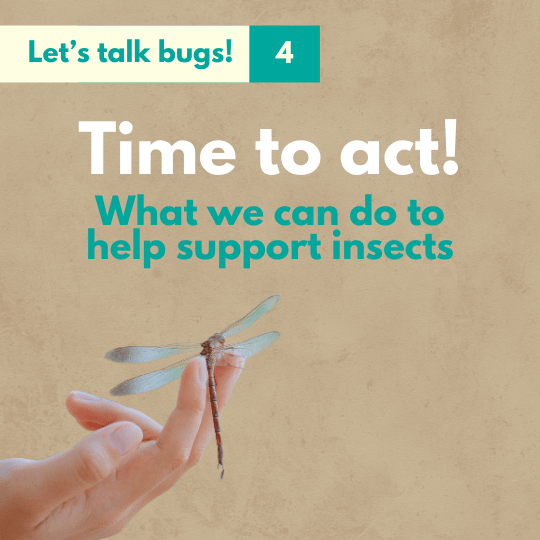
Let’s first delve into how two of our member organisations UK Youth 4 Nature (UKY4N) and Jeugdbond voor Natuur en Milieu (JNM)
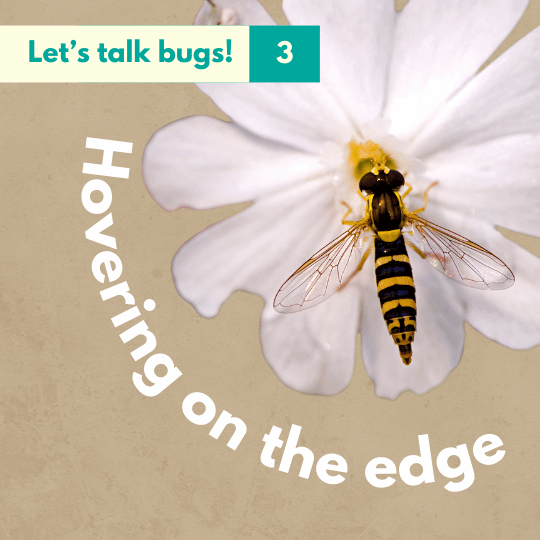
Many arthropod groups are not well understood or equally loved as other arthropod groups by the average European. One such group are
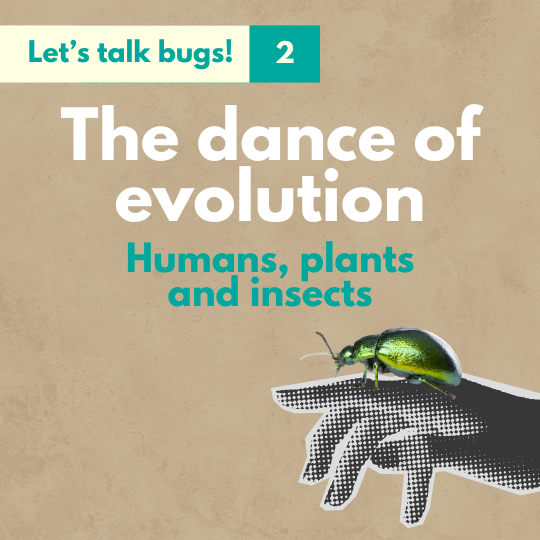
Have you ever wondered how the intricate relationship between insects, plants, and humans came to be? Let’s travel through time to uncover
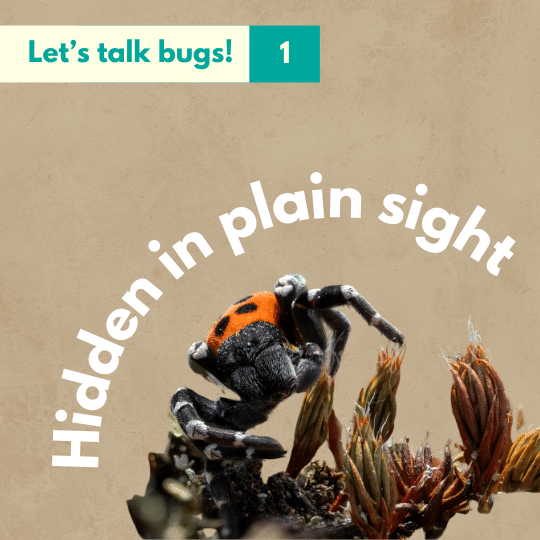
Let’s look at some of these arthropods that are often hidden in plain sight
More To Explore
Exploring the biological and ecological importance of Europe’s First Wild River National Park | Article
https://yeenet.eu/wp-content/uploads/2023/08/Europes-First-Wild-River-National-Park1.png 540 540 YEE https://yeenet.eu/wp-content/uploads/2018/11/logo-yee-728x1030.png YEE2023-08-23 17:25:462023-08-25 06:09:19Exploring the biological and ecological importance of Europe's First Wild River National Park | ArticleI want to see my community from another perspective
Iusip, a 23-year-old from Georgia, is currently studying Management Engineering in Poland. He has been involved in the NGO field for three years, establishing his own NGO at the age of 19. Through his organisation, he provided opportunities and assistance to numerous individuals and facilitated participation in projects in Europe.






Tell us a bit about yourself. Who’s Iusip?
I’m 23 years old and from Georgia, but now I’m studying in Poland in the faculty of Management Engineering for my bachelor’s. Until now, I have been involved in the NGO field, and when I was 19 and was studying in Georgia, I established my own NGO with my friends. I have been writing projects, and managing teams for three years, and I got a lot of experience.
How did you first get involved with NGOs?
The first organisation was the “Youth Association DRONI”, which had a lot of local projects and in Europe. I have participated in some of the projects in Turkey and in Georgia. I explored a lot of opportunities for youth, and I saw that as a member of an ethnic minority in my country, my ethnicity is Azerbaijani. Most people don’t know about these opportunities. So we made a Facebook group, volunteer-based, and we were sharing all these opportunities for three years. There were a lot of people that have participated in these projects and used these opportunities.
After that, we established our own organisation where we had our own projects. We even got country labels for projects, and we helped people to go and participate in several projects in Europe.
Where did the idea of creating your own organisation come from?
After becoming a volunteer at one of the biggest organisations here in Georgia, I saw that there are a lot of things that youth can do. You can go to another country, explore the country, meet a lot of new people, and gain a lot of skills at the same time. I said to myself: I have to share this with others as well, they must know and develop themselves. So we started with the Facebook group, and we started sharing these opportunities on a daily basis, they were writing and asking us questions, and we were trying to help them with all the matters.
Then we said okay, let’s make an organisation as well, so we can have our own projects and we can be a sender and host organisation at the same time. And in 2020, we registered and started writing projects, finding donors, and partners for us, and we had a lot of projects during these two years and met a lot of people during this period. Our main target group was youth in Georgia, and especially ethnic minorities, and our aim was to develop and motivate them.
Can you share a bit about one of your projects?
There were several projects, with partners or just by ourselves, but one of the main ones that I remember was ‘ethnohunt’. It was a treasure hunt game for two days, and there were people of different ethnicities. We had training about discrimination and tolerance, and we had a workshop to paint the t-shirts, so you had to paint it according to these topics, like tolerance, and in the next stage, you go outside of the room and play ethnohunt.
Do you think it is harder for minority groups to get recognition and have a space among other activist groups?
Sometimes I feel really lucky because if you are a member of an ethnic minority here, at least you have an advantage in languages. You are in Georgia, so you already know Georgian, you know Azerbaijani, you have Turkish, you study English you already know four languages. Even when I’m going to the projects, there are people from Azerbaijan, Georgia, English English-speaking countries, and I’m able to speak with all of them, even in their own language. There are a lot of opportunities for us as we are people with multiple languages.
But not all people are so lucky, because as you may know, people mostly live in the villages and they don’t have that much opportunity to learn English or learn Georgian. Moreover, the educational conditions are not that good in the regions.
What’s next for you, and what is your ultimate goal?
“My main aim was to see the community from another perspective, to change them, to try to affect them positively.”
There might be a lot of negative things in the community if you start discussing it from the educational, social, or even political side, and I was trying to find people with whom I can discuss science or technology. I believe that with all the things I was trying to do in the NGO sector, people were getting more and more developed in different fields. They may be lawyers or IT guys, but at least they must start doing this and look to the global side and try to gain more and more experience to become something different. And to do that, you need to cross your borders, the borders you have inside, and your complexes. I was trying to work against it, against complexes and stereotypes.
“Even just one project can change a person.”
I had experiences like this here as well. Because they have many competencies, speaking in their own language, speaking in another language, speaking in front of an audience, communicating, and many more skills. And even in 10 days, they were coming back, and they were totally changed. It affects their lives, and their career as well, and from that one individual, you can reach the community level, but step by step, one by one.
What’s your advice for people who want to start getting involved?
My advice would be not to be afraid because I mainly saw situations where they are afraid. Of being alone, afraid of being lost in another city or country, you can find a number of reasons. They just need to step forward. Otherwise, they will not be able to experience it.
I always was the person that would step forward first. My motivation for this was curiosity, I was curious about everything. I was going everywhere trying to explore something new, and they must be curious as well, and they must not be afraid of anything. When you are going somewhere, you have never been, or when you are talking to people you don’t know, you are exploring something new, you are adding some color to your picture. It makes your life and yourself more developed and better. That’s basically what I can advise, according to, of course, my experiences. I’m still 23 years old, and I still have a lot of years to give advice.
What do you want for the future?
Probably at this moment, I would like to have peace. There are a lot of kinds, like not having a war, if you are mentally stable, you don’t have conflicts around you… It can have different levels. I just want to have peace around me, and I would like to see the eyes of people with peace. Here mainly, I see people with tired and not motivated eyes, and I would like to see their eyes with more peace.
Other interviews

#YEEinterview: Souji
Have you ever wondered what to do with the used vegetable oil that is left
Introducing Iusip | Showcasing the Unheard
https://yeenet.eu/wp-content/uploads/2023/10/Iusip.png 675 675 YEE https://yeenet.eu/wp-content/uploads/2018/11/logo-yee-728x1030.png YEE2023-08-01 14:56:002023-10-02 15:28:06Introducing Iusip | Showcasing the Unheard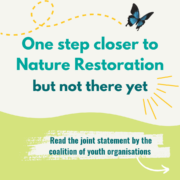
Recently we celebrated the positive vote for the Nature Restoration Law by the European Parliament, which is sending a strong message: restoring nature is an obligation. The European Union has put itself on the path to being a champion and pioneer of nature restoration globally, living up to promises made to citizens and at the global negotiation table.
We thank all the MEPs that listened to our perspective, welcomed our recommendations and voted also for the next generations. We want to particularly show our appreciation towards the work and the words of Rapporteur César Luena, who publicly recognized the efforts made by youth in the advocacy for this law.
However, we cannot ignore that almost half of our political representatives refused to restore nature, cold-shouldered the youth and refused to guarantee us a liveable environment. The law is still far from what science tells us it is urgent to do.
We acknowledge with heavy hearts the adoption of amendments that substantially watered down the law. The amendments, especially those that delay targets and the initiation of actions, significantly shift the responsibility and efforts on us in the future. This is not fair from an intergenerational justice perspective, which the EU has agreed to respect as a guiding principle at COP15. In particular, refusal to accept the principle of non-deterioration means that we will continue to witness the degradation of our habitats, and so will our children and grandchildren.
Help us spread the word! Share this statement
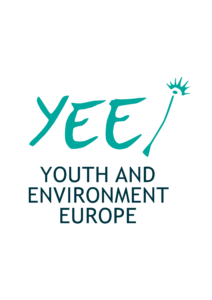
“While the unity and the strong, loud voices of young people ahead of the plenary vote on the Nature Restoration Law once again demonstrated the will and drive for positive change, the very close vote showed that this is not the case for a lot of MEPs deciding on policies that will determine the state of the ecosystems we depend on. This law is not only about Nature Restoration. It is about fighting for the continued existence of a liveable planet, which the law that was adopted on the 12th of July, does not do. This is why our work is not done and we will continue to fight for a law that is just - not only for us, but for the planet and generations to come.“

“Heeding the calls of scientists, young people and environmental activists, a narrow majority of MEPs voted in favour of the Nature Restoration Law during the Plenary of the European Parliament, an outcome that was not guaranteed but one that we celebrate as young Europeans. However, the vote’s close margin of victory underscores the significant opposition still facing the Law. It has been compromised in the voting process and the resulting legal amendments the Parliament agreed upon severely weaken the effectiveness of the NRL in combating biodiversity loss and environmental degradation. We need a more ambitious Law to ensure a future where both people and planet can thrive! Our work is not done and we demand that the Commission, Council and Parliament pass a Law that is as strong as possible and does not put the burden of mitigating environmental damages and economic short-sightedness on future generations.“

“The positive vote in the Parliament is a bittersweet success. It is great to see many MEPs that listened to science and young people and to see the EU sending out this message, but the journey is still long. However, laws or not, restoration activities and initiatives have been growing exponentially in the past years. And this will never stop: the restoration and rewilding movement is a snowball in a free fall down a slope, getting bigger and bigger. While politicians discuss in rooms, tons of people, of young people, are out there restoring and rewilding. This is the future. The law is not as ambitious as we wanted it? Then we will be ambitious, and we can be it now.”

“The vote in favour of nature was a crucial and most needed signal to the world.However, the narrow result, the disinformation campaign including blunt claims against all scientific evidence is very worrying for us. Let us hope, that during the Trialogue process some more common sense prevail and get something more ambitious than just restoring Nature 2000 areas. We all, and youth in particular, depend on a healthy environment - and we need to take the necessary steps to ensure them rather yesterday than tomorrow.”
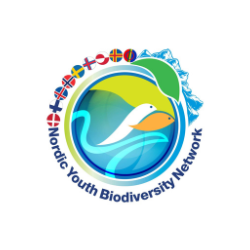
“The NRL is the most crucial legislation for european biodiversity of my lifetime. For environmentalists in every part of society to finally have political will on the environments side should be a celebration. But seeing the Law being so close to get rejected and at the moment being so watered down from it's once clear agenda of saving our nature, is a new way politicians have made me disappointed. However, youth will continue our efforts to restore Europe's biodiversity, and we hope one day the elected few will follow the actual will of the people and join us truly in stopping the biodiversity crisis.”

“The Parliament's vote can be seen as a positive development, acknowledging the efforts made to secure a more promising future for all. The approval of the Nature Restoration Law reflects a significant stance by EU institutions in support of nature, despite the fact that recent negotiations have led to a dilution of its original objectives. Regrettably, at the national level, we, as GYBN Italy, hold the view that the situation is even more unfavorable, and Italian youth have experienced deep disappointment. Italy should ideally take a leading role in the preservation and restoration of biodiversity. However, to our dismay, nearly all Italian MEPs voted against this vital legislation. This decision by the current political power has effectively disregarded the expectations of young people on almost every level. As a result, bitterness lingers among the younger generations, as they feel unrepresented, signifying that our endeavors to conserve and restore nature will not come to an end with this setback.”
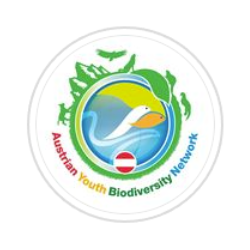
"Even though negotiations for the Nature Restoration Law will see another day, the picture this whole process has painted is bleak, not only for Europe's nature and biodiversity, but for trust into political officials and democratic processes. Are we supposed to celebrate this small majority within Parliament that barely aknowledged science and the nature crisis?"
Read the youth position on EU Nature Restoration Regulation.
The coalition of youth organizations whose representatives released the statements above that elaborated the youth position represents more than 20 million young Europeans.
Learn more about the #restorenature campaign
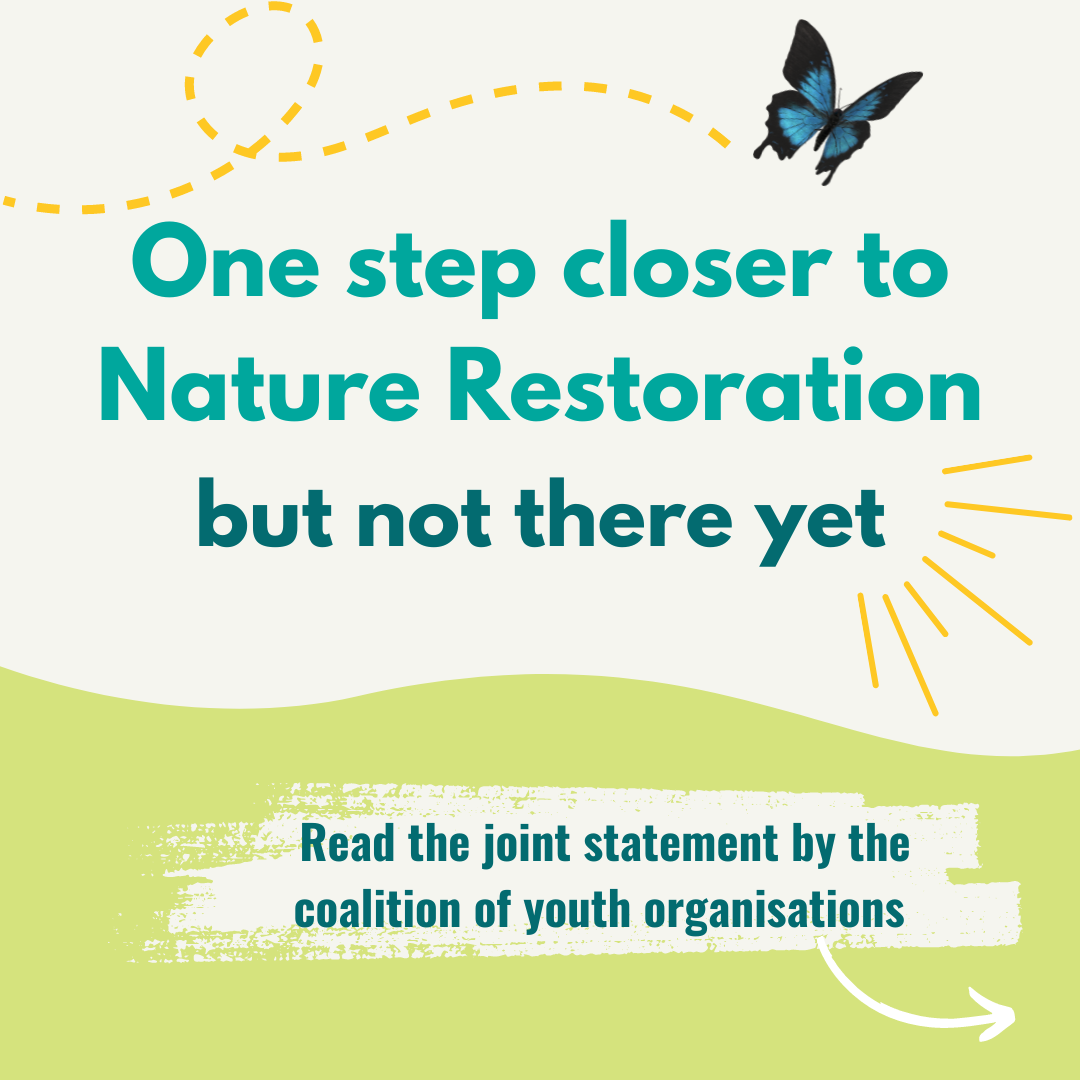
The recent positive vote for the Nature Restoration Law by the European Parliament sends a strong message on the obligation to restore
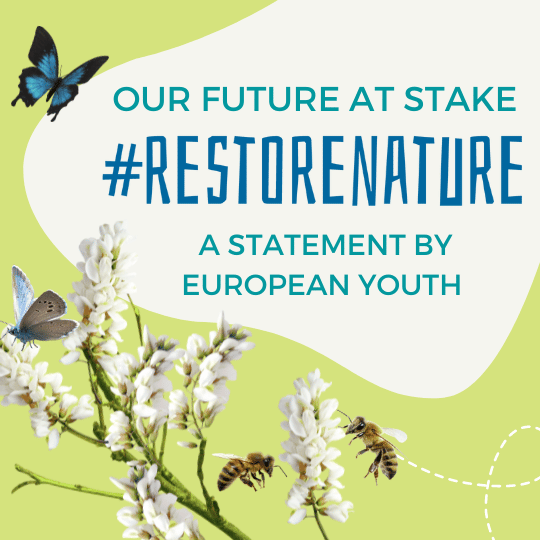
The coalition of youth organisations released their statements about the necessity and urgency to adopt the Nature Restoration Law within the European

Join us and over 200 NGOs and ask your decision-makers to adopt a solid and urgent implementation of the law that can
More To Explore
One step closer to Nature Restoration – but not yet there | #RestoreNature
https://yeenet.eu/wp-content/uploads/2023/08/One-step-closer-to-Nature-Restoration.png 1080 1080 Eva Kloudová https://yeenet.eu/wp-content/uploads/2018/11/logo-yee-728x1030.png Eva Kloudová2023-08-01 13:33:502023-08-01 13:34:27One step closer to Nature Restoration - but not yet there | #RestoreNatureWe have a responsibility to leave a clean and sustainable environment behind us
Disclaimer
The views and opinions expressed are those of the authors and do not necessarily reflect the official policy or position of YEE.
Rimaz is a 19-year-old university student from Syria, currently living in Istanbul, Turkey. Rimaz is passionate about environmental issues, particularly the impact of acid rain. She has created a project to educate students on this issue, which involves treating plants with acid rain, sun, and normal rain to demonstrate the effects on plant life. Rimaz believes in the importance of young people being actively engaged in shaping a sustainable future and is motivated by her small efforts contributing to a better future.
Tell us a bit about yourself. Who’s Rimaz?
My name is Rimaz and I am from Syria, but I’m living in Turkey, Istanbul. I’m 19 years old. I’m a university student. I’m studying biomedical engineering and I’m also working as a teacher in a school for children of foreign people. I teach the Turkish language.
What are the projects you are involved in?
I’m working as a volunteer in Medicorya which is a group for young people who are studying biomedical engineering with the aim of introducing our department to other countries. I’m working there as an academic coordinator, making analyses about the university programs and researching which companies might the students need. We collect this information and present it in high schools with the aim of improving our education system.
I am also in the Yeni Dünya which is a member organisation of Youth and Environment Europe and I’m working there with international students. You can find more than 100 students from different countries. We are trying to organize ourselves into groups depending on our hobbies and our interests and I am a representative for the Syrian students.
We introduce our countries to people from other countries by holding presentations and sharing our historical heritage and geography. I’m from Syria and we have a war in Syria so I often talk about the Syrian children and try to organise people to get help for these children.
What does your engagement mean to you?
Being part of these organisations, I do not feel like I am alone on this journey. I’m establishing communication with these young people because they have fresh perspectives and innovative ideas and when we get together I feel inspired. They also provide a platform for my voice to be heard.
Why should young people be active in their lives?
Young people have a significant role in shaping a sustainable future for the next generations. Being actively engaged enables you to learn and to organise yourself with other people. If there is something that you care about that is in danger, you can have the support of the group and address it together. Even if they are small efforts, they will have a big positive impact with the potential to create big change.
What are your future plans?
In one of my projects I focus on acid rain, and how it arises due to human activity, because of industry and transport. It can affect our historical places and that means it will affect our economy and our tourist places because it destroys the stone.
I did this project and I showed the other students how we can harm our environment in this way. I will try to find some organizations, and projects that also focus on this issue. And I would like to work with like-minded people to have a common goal on this topic.
How did you start working on this project?
We had a lesson about pH and our teacher told us about acid rain and how we can know if it’s normal rain or rain with a lower pH. I started to research the environmental impacts of acid rain and its harmful causes. Then I created a project with our teacher about this and now each year they repeat it to the other students and they show it to them in other schools and cities.
What does this project look like?
You take four plants and then you treat one of them with acid rain, the second one with sun, and the third one with normal rain. In this way, you can show the students how acid rain affects the plant. This shows everyone the importance of protecting the environment.
Why should people care about the environment according to you?
People should care about it because we have a responsibility to leave a clean and sustainable environment behind us. They can think about their close ones, their sister, their children and their future. With each day it is a bigger challenge to face the impacts of environmental destruction. That is why we should get together to find a solution and be honest about environmental issues. If you are interested in this topic, I advise you to join some organizations to get engaged.
What drives you forward?
My motivation is, I believe, my small efforts that contribute to a better future and knowing this is enough for me to continue my work in this way. With whatever you start, the beginning might feel a bit difficult, but then it gets easier because you will grow and meet new people and gain knowledge about the topics that interest you. It will get easier when you see the results, you will be happy and will get stronger and more motivated to continue.
Other interviews

Introducing Vladislava | Showcasing the Unheard
Meet Vlada, an 18 years old activist from St. Petersburg, Russia. Vlada coordinates Fridays for Future Russia and is especially interested in the melting of permafrost in Russia, the fate of indigenous peoples, ecofeminism, food security, and a just transition. She studies ecology at a Russian state university and dreams of doing a master’s degree on climate change in Europe, as this subject is not available anywhere in Russia.

You will have new roads, but nobody to drive on them | Piotr Czerniejewski
Meet Piotr Czerniejewski, a Polish Youth and Climate Activist who is actively involved in the Just Transition process of his local area and has been promoting the inclusion of young people.

We need to make climate education a reality | Emilia Rygielska
Emilia is a 17 years-old activist and climate educator from Poland. In the following article, she talks about her experience with teaching kids about the climate crisis and why she thinks that politicians stand in the way of change.

Make at least one small eco change in your life | Ola Czajkowska
Social media on environmental issues can sometimes be the only source of knowledge for young Poles. Ola Czajkowska, a 26-year-old resident of Warsaw, has taken matters into her own hands.
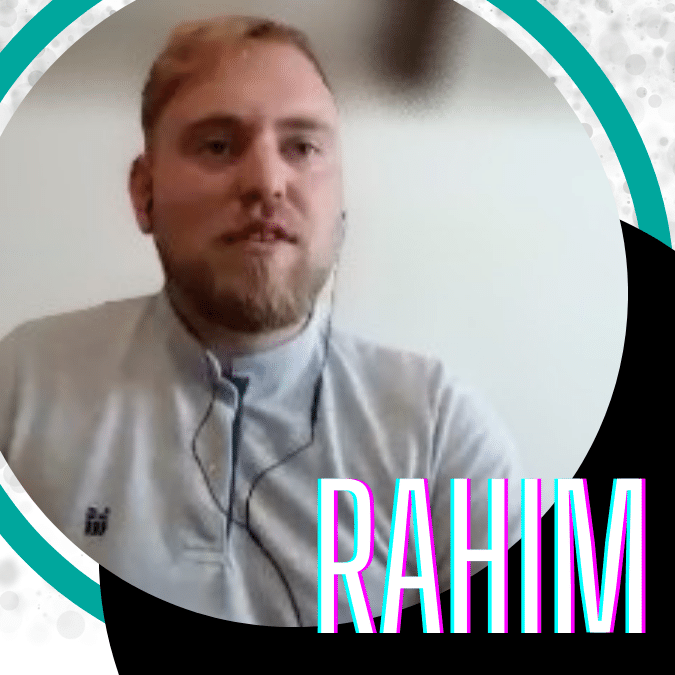
Introducing Rahim | Showcasing the Unheard
Rahim Zehdiev, a 27-year-old volunteer and green ambassador at Young Improvers for Youth Development in Smolyan, Bulgaria, is passionate about creating positive changes in his community and empowering young people, particularly in environmental issues. He is involved in various projects aiming to address environmental challenges and empower young individuals from marginalised communities.
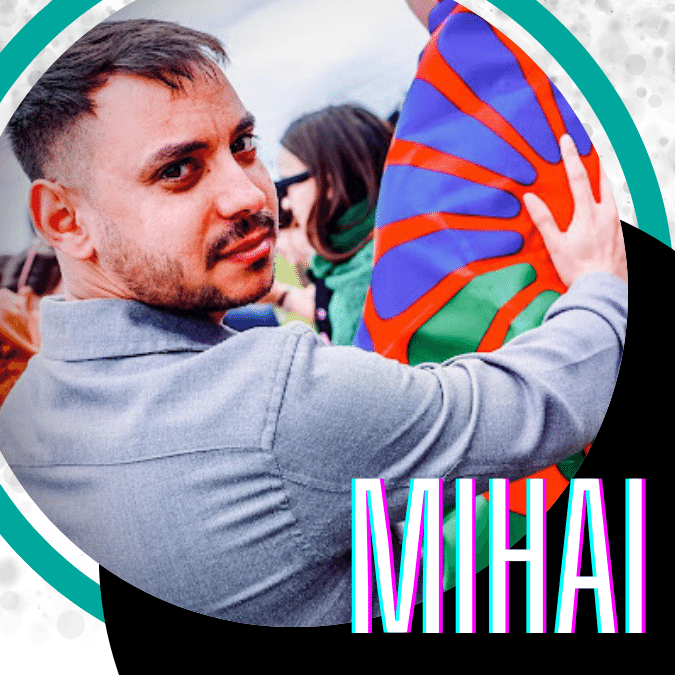
Introducing Mihai | Showcasing the Unheard
Mihai Oancea, a young Romanian from a traditional Roma community, is a founder of the youth NGO, ROMA T.E.A.M. Association. They offer mentorship programs and screening activities for vulnerable communities, with a focus on empowering young people. Mihai’s vision is to create community centers for education and mental health, and he believes that Roma people should be involved in different contexts to fight against racism and make the community more inclusive.
Introducing Rimaz | Showcasing the Unheard
https://yeenet.eu/wp-content/uploads/2023/10/rimaz.png 1080 1080 YEE https://yeenet.eu/wp-content/uploads/2018/11/logo-yee-728x1030.png YEE2023-07-05 15:45:222023-10-05 15:48:13Introducing Rimaz | Showcasing the UnheardINC-2: a session for nothing?
Why is it so difficult to reach an international treaty on plastic pollution?
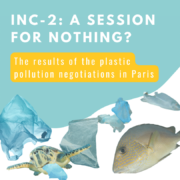
Written by

Mathilde Angeledei
Contents
Visual summary












Share this article
A new phase of the international treaty to end plastic pollution negotiations took place in Paris, at UNESCO headquarters, from May 29 to June 2, 2023.
Plastic has become one of the most significant sources of water and soil pollution.
According to the latest OECD figures, 460 million tonnes of plastic waste are produced every year. This figure has doubled since 2000 and is set to triple by 2060.
Although several countries have taken measures to deal with plastic waste, such as the European Union with its Directive on single-use plastic in 2019, or Rwanda in 2008, which was the first country in the world to ban plastic bags, 75% of the plastic waste found in the oceans comes from poor waste management. Indeed, most countries do not have the infrastructure to manage their own plastic waste.
Others, like Japan, export over 90% of their plastic waste to developing countries that have no means of recycling it. Plastic waste is at best burnt, at worst abandoned in the wild, creating huge open-air dumps. China produces 32% of the world’s plastic, a leap of 82% in ten years. What’s more, 10% of the world’s plastic is emitted by soda giants Coca and Pepsi.
Finally, the treaty is also part of the drive to move away from fossil fuels, as plastic is a direct derivative of petroleum.
Why is it so difficult to reach an international treaty on plastic pollution?
The Fifth United Nations Environment Assembly adopted a landmark resolution in Nairobi, Kenya, in March 2022 with a view to negotiating a legally binding global treaty to combat plastic pollution by the end of 2024. It will be based on a comprehensive approach covering the entire life cycle of plastics. To achieve this, five working sessions are planned, the first of which was held in Uruguay in November 2022. This first session laid the groundwork for future discussions by identifying the expectations and ambitions of the main delegations, with France hosting the second negotiating session.
An urgent treaty, yet negotiated at a snail’s pace
The second negotiation session got off to a rocky start, with more than two days lost on protocol issues. A coalition led by Saudi Arabia, Brazil, China, and India clashed with the presidency over whether or not to resort to voting in the event of a lack of unanimity in the future consideration of a draft treaty. The resolution of the controversy was postponed.
Finally, after a week, the Committee decided that “The International Negotiating Committee [INC] requests its Chairman to prepare, with the assistance of the Secretariat, a draft first version of the legally binding international treaty“. The text will be examined in November at the third meeting of this committee in Nairobi, then in April 2024 in Canada, and in November 2024 in South Korea, with the aim of a definitive treaty by the end of 2024.
Non-governmental observers
The treaty process includes the possibility for non-governmental observers to attend almost all the negotiations. However, at the Paris session, due to the size of the room, only one person per NGO could be present. Despite a statement signed by many associations, the length of the negotiations did not allow many NGOs to make any comments. It is therefore very important to follow the treaty news on the United Nations Environment Programme page, and the CIEL page which is in charge of coordinating the youth NGO accredited to the treaty.
An urgent treaty, yet negotiated at a snail’s pace – that’s how we might sum up this second phase of negotiations. We can only hope that future negotiations in Nairobi will be more prolific. In particular, the 175 countries will have to agree on the definition of plastic waste and the potential creation of a fund to help developing countries manage this waste.
And finally, there remains the thorny question of plastic waste already in the environment: who will be responsible for paying for its management?
More articles

Let’s first delve into how two of our member organisations UK Youth 4 Nature (UKY4N) and Jeugdbond voor Natuur en Milieu (JNM)

Many arthropod groups are not well understood or equally loved as other arthropod groups by the average European. One such group are

Have you ever wondered how the intricate relationship between insects, plants, and humans came to be? Let’s travel through time to uncover

Let’s look at some of these arthropods that are often hidden in plain sight
More To Explore
INC-2: a session for nothing?
https://yeenet.eu/wp-content/uploads/2023/06/The-results-of-the-plastic-pollution-negotiations-in-Paris.png 810 810 Eva Kloudová https://yeenet.eu/wp-content/uploads/2018/11/logo-yee-728x1030.png Eva Kloudová2023-06-23 09:15:542023-06-23 09:23:43INC-2: a session for nothing?Our future at stake: European youth urges once again to adopt an ambitious Nature Restoration Law
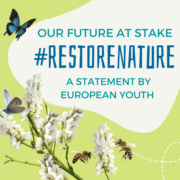
We, as concerned youth all over Europe, want to reiterate the necessity and urgency to adopt the Nature Restoration Law within the European Parliament.
What is being negotiated is not only a law: it is our future.
Young people and future generations deserve to grow up and live in healthy nature and functioning ecosystems. This, looking at the gloomy status of European species and habitats, can only be reached with an ambitious law that prescribes effective action now.
A watered-down law means postponing on us, later, the efforts that should be made now – and this is not fair.
The rejection attempts by conservative and right-wing groups, led by the European People’s Party (EPP), are alarming, are failing youth, and are failing to consider us as stakeholders of the present and the future.
While we appreciate the efforts of other parliamentary groups such as the Socialists and Democrats (S&D), the Greens, and the Left, who have stood their ground and voted in favor of the Nature Restoration Law, we are disheartened by the disinformation campaign around this law. Spreading falsehoods and withdrawing from negotiations only hinders the progress necessary to address climate change and nature loss, gambling our future.
As the vote on the remaining amendments and the final report approaches on June 27th, we call on all Members of the European Parliament to prioritize the future of our planet and live up to their promises to youth. The Nature Restoration Law is not merely an environmental issue, it is a matter of intergenerational equity.
Help us spread the word! Share this statement

“Let’s state it clearly: the success of the EU Green Deal depends on the adoption of the Nature Restoration Law. This is not just a political vote, but a matter of justice: the youngest and future generations, who will face the biggest impacts from climate change, need to be supported by strong environmental legislation today to be able to exercise many of their human rights tomorrow. The only fact that the law risks being blocked is a shame, and shows once again that the EU is not taking the climate crisis seriously. For the sake of the EU credibility and climate leadership globally, we urge policy-makers and political parties to align and adopt the law, as we are still on time to avoid the mistake of the century.“

“On June 15th, the ENVI committee narrowly avoided a terrible setback for nature, by defeating attempts of right-winged groups to reject the Nature Restoration Law. While young Europeans can breathe a sigh of relief, the race to nature recovery is not over yet. As the voting continues on June 27th, European youth worry about what their future is going to look like.Young people have a right to live on a healthy and habitable planet, and political representatives have a duty to secure their future and the future of our next generations.“

“Despite positive steps at the last voting session, the sharp split in ENVI and the tight votes are worrying youth. In such short time spans, young Europeans have witnessed so much nature degradation, with very little improvement and increasing negative trends despite existing laws. This means that a strong law is not just an ambition, it is a necessity to get out of the business-as-usual framework: we need a game-changer. We urge MEPs to recognize this and vote (also) for the future of those that will have to deal with the consequences of current inaction, for our children and grandchildren. Together we can rally the resilience of nature to ensure functioning and healthy ecosystems, bringing not only food security but also hope to European citizens.”

“The Nature Restoration Law is not only a matter of urgent importance for European Nature and critical for the living conditions we as youth will face in the future – it is also a crucial signal we are sending to other countries to live up to the commitments made in Montreal in December last year. Who, if not us, can be the ones going ahead and restoring our degraded landscapes? How can we expect other countries to live up to their promises, if we can’t do it? The European Union now has a chance to secure a better planet for the youth here and elsewhere in the world.”

“The EU ratified the Global Biodiversity Framework in Montreal this Christmas, promising the world that restoring Nature would be the top priority. The Nature Restoration Law is the fruit of that labor. A great tool to finally reverse the loss of biodiversity. We cannot falter at the finishing line and reject the most crucial biodiversity legislation in Europe of this century. The Nordic youth urge our decision-makers in the EU to do what is right for the existing and future generations and vote YES to this Law.”

“Backed by scientific evidence, the Nature Restoration Law emerges as a transformative force that benefits both nature itself and humanity at large. Youth, as custodians of the future, urgently need this law to secure a thriving planet. It signifies a profound commitment to safeguarding biodiversity's intrinsic value, preserving the web of life that sustains us all. Recognizing that our own survival is intricately linked to the well-being of nature, we implore the Members of the European Parliament to secure a strong, ambitious Nature Restoration Law and forge a path towards a harmonious coexistence with the natural world.”

Only with intact ecosystems do we have a chance of overcoming the climate crisis. The proposed legislation would contribute significantly to the implementation of the EU's environmental and climate goals, safeguard the livelihoods of numerous species, and ultimately create a secure future for young and future generations. If the opposition and pushback against this law ought to show us one thing, it shows that the law has the potential to be truly transformative, this is why we see regressional voices spreading false information and doing dirty campaigning – they are afraid of transformative change! This short-sightedness and ignorance towards the ecological crises of our time endanger our future. No matter if on EU, national or regional level: those who block nature conservation and restoration today are jointly responsible for the advancement of the climate crisis and the stability of our future!"
Read the youth position on EU Nature Restoration Regulation.
The coalition of youth organizations whose representatives released the statements above that elaborated the youth position represents more than 20 million young Europeans.
Learn more about the #restorenature campaign

The recent positive vote for the Nature Restoration Law by the European Parliament sends a strong message on the obligation to restore

The coalition of youth organisations released their statements about the necessity and urgency to adopt the Nature Restoration Law within the European

Join us and over 200 NGOs and ask your decision-makers to adopt a solid and urgent implementation of the law that can
More To Explore
Our future at stake: European youth urges once again to adopt an ambitious Nature Restoration Law
https://yeenet.eu/wp-content/uploads/2023/06/OUR-FUTURE-IS-AT-STAKE.png 540 540 YEE https://yeenet.eu/wp-content/uploads/2018/11/logo-yee-728x1030.png YEE2023-06-21 10:50:072024-02-26 16:32:10Our future at stake: European youth urges once again to adopt an ambitious Nature Restoration Law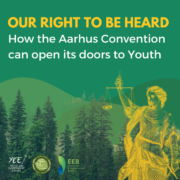
Written by
Margarida Martins (EEB), Ruby Silk (EEB) and Emma Pagliarusco (YEE)
Contents
Visual summary










Share this article
What is the Aarhus Convention and why is it important for young people and future generations?
Climate change poses real threats to the future of the youngest generations through both extreme and gradually escalating weather events, with manyfold repercussions. This looming threat has even proven to lead to “climate anxiety”, a serious and negative psychological phenomenon affecting the current generation of young people in particular and associated with the “perceived failure by governments to respond to the climate crisis”.
The latest IPCC report echoes these disproportionate threats to the youngest generations and sheds light on the intergenerational dimension of the climate change problem: in order to respect, protect and fulfil the rights of today’s youth and future generations, there is an urgent need for environmental laws which are more ambitious than ever before and implemented in the fastest possible way.
The Aarhus Convention and young people
Since its adoption in 1998, the Aarhus Convention has been hailed as the leading international agreement on environmental democracy. It has brought three key environmental rights to our doorsteps: the right to information, public participation in decision-making and access to justice in environmental matters.
The idea underpinning the Convention is no other than participatory democracy: to empower citizens and civil society to participate in environmental matters. For this reason, national authorities of State Parties are legally bound to make Aarhus rights effective. This means that they have to ensure the implementation as well as enforcement of the Aarhus provisions within public processes. Since its enactment, numerous Communications have been brought by NGOs as well as individuals to the Aarhus Convention Compliance Committee to challenge state practices, with energy and spatial planning being the most common sectors addressed.
Article 3(8) of the Convention also states that Parties shall ensure that persons who exercise their Aarhus rights are not penalised for their involvement. This is critically important since environmental defenders are constantly and increasingly under attack across the globe, facing intimidation, harassment, stigmatisation and criminalisation, assaults and even murder. Among them are a high number of young people and children. Global Witness has recorded that 1,539 environmental defenders were killed between 2012 and 2020 worldwide, and the real figure is likely much higher, given that many murders go unreported.
Unfortunately, young climate activists systemically face many different challenges when seeking to exercise their rights protected by the Aarhus Convention. The targeting of youth activists is taking place in multiple and different ways across Aarhus State Parties: through brutal repression of climate movements; enacting new laws to limit and criminalise strikes (with the latest example of Italy); and through intimidation against environmental defenders (e.g., through SLAPP strategies; and even violence such as in France). There are increasingly more barriers to youth public participation, access to information and access to justice. In this regard, States constantly fall short of their obligation to guarantee the right of public participation of young people in environmental decision-making. Youth underrepresentation and generational imbalances are incompatible with democratic participation. Besides, the costly nature of going to court – which we call climate litigation – very clearly impairs the right of young people to access justice.
The Aarhus Convention is a vital piece of legislation that can ensure that the principle of intergenerational equity is included in environmental action. Article 1 recognises the role of the Convention’s pillars in contributing to the protection of the rights of every person of present and future generations. The recognition of the rights of future generations in a legal text – and an international treaty at that – is very rare and should be highlighted. It has the potential to bridge the gap left by the lack of youth representation in decision-making at the national level, ensure a level playing field in the protection of youth activists and serve as good practice for other international environmental legal frameworks.
Youth participation in Aarhus processes
Why should the Convention promote and incorporate young voices?
There are many reasons why young people and youth organisations need to have adequate capacity to exercise their Aarhus Convention rights. Young people have a bigger stake in future problems, as they have lived in an epoch which is also defined by environmental crises.
Youth-led movements and actions have taken an active stance on promoting sustainability and protecting the environment, which is unfortunately not reflected in the current environmental legal framework, apart from references in non-binding international documents such as Agenda 21, a plan of action adopted at the 1992 Rio Earth Summit, which is far from enough.
Despite its capacity and uniqueness, even the Aarhus Convention is far from being considered a well-functioning instrument for the promotion and protection of procedural rights of the youngest: just speaking about its processes, throughout YEE’s experience in two task forces, one MoP and one WGP, we noticed a substantive gap left by the lack of youth participation. This representational imbalance presents several hurdles to the effectiveness and legitimacy of the legislative process.
First of all, youth participation is key to the legitimisation of environmental decisions amongst the young public. Considering the disproportionate climate change impacts that the youngest generations will suffer from, and considering that youth represents 30% of the population in the world, excluding youth from environmental law is one step towards climate injustice and systemic suppression of youth voices.
Secondly, the urgency felt by youth with regard to the climate emergency is unique in its kind and, when taken into consideration adequately, leads to the adoption of more ambitious and binding environmental laws.
Thirdly, including youth voices in the Aarhus Convention processes is also in line with adopting a rights-based approach to environmental legislation, therefore contributing to a more holistic consideration of the various impacts of climate change. Considering that climate change is also a human rights crisis, youth voices in the Aarhus Convention processes are needed in order to take into consideration the disproportionate impacts of climate change on all groups, including the marginalised and potentially vulnerable ones.
Last but not least, in line with Article 1 of the Aarhus Convention the principle of intergenerational equity should be given effective meaning and implemented at a national level as well as at the Convention level. This is impossible without including young people in decision-making processes.
Opportunities for youth involvement
How youth can be better involved in processes (what the Secretariat can do)
In light of the previous section, the Secretariat of the Aarhus Convention is uniquely positioned to promote intergenerational dialogue and enhance the exercise of procedural rights amongst youth. Here are a few steps it can take to promote intergenerational equity:
- Youth should be involved in a systematic way in the Aarhus processes, for example through the establishment of a permanent youth advisory board, (such as UN Youth Advisors, UN Human Rights Youth Advisory Board). Regarding its feasibility, the Secretariat could disseminate the opportunities for youth participation to national youth focal points and NGOs to ensure that the call is open and transparent and that different youth-led groups are represented in all their diversity. The appointment of such youth envoys could follow an election process, or be the result of a competitive application process;
- Youth movements and representatives need to be actively supported in the exercise of access to justice. Cost abatement of climate litigation and access to the courts is essential in order to ensure access to justice for everyone (including young people) without any discriminatory obstacles. Promoting access to justice in environmental matters amongst youth also means promoting and offering pro bono legal counselling, as linguistically and culturally appropriate, to climate activists engaging or willing to engage in climate litigation, with a special focus on marginalised and potentially vulnerable groups.
How to include youth in Aarhus rights at the national level
The Aarhus Convention is also a good forum to mainstream youth participation in environmental decision-making at the national level. Through Aarhus-related processes intergenerational and multi-stakeholder dialogue can take place, good practices can be shared and the principle of intergenerational equity can be promoted. In order to include youth in Aarhus rights at the national level, State Parties should take the following steps:
- Parties should include youth representatives in the Convention processes with a vision to foster meaningful youth engagement and ensure fair democratic representation in line with the principle of intergenerational equity.
- States should adopt the necessary legislation that reflects their environmental goals, taking into account any international obligations. In this process, it is vital that there is access to justice provisions, which ensure that the public concerned can scrutinise authorities’ decisions which have an impact on the environment (per Article 9(3) of the AC). The process should also be made accessible to youth.
- States should ensure that environmental information is made accessible to the youngest members of the public, including children.
- States are urged to decriminalise youth activism and start a process to involve youth activists in decision-making processes as an alternative channel.
- Connected with this last point, it is fundamental that States support more systematically the mandate of the Special Rapporteur on Environmental Defenders and collaborate with youth and non-youth NGOs active on the matter.
The Rapid Response Mechanism, a mechanism under the Aarhus Convention that provides emergency response to environmental defenders in situations of danger, also addresses the many challenges youth climate activists face, including criminalisation and repression following climate action. Young climate activists need protection. In this regard, appointing youth national focal points or hubs in coordination with the RRM would be beneficial as it would allow young people to easily approach them when seeking the enforcement of Aarhus provisions. The mandate of the Special Rapporteur should take into account social and cultural differences and collaborate with national governments to abate any linguistic, cultural, social and political barriers to the enjoyment of Aarhus rights. Likewise, it will be necessary to devote provisions to young people, with special attention to the possibility for underage people to benefit from the RRM.
Stronger Environmental Rights on the Horizon for the Youth
In conclusion, all people of the present generation should be able to meaningfully and effectively exercise their rights under the Aarhus Convention and shape the environmental and climate policies that affect their lives and the lives of future generations. All Parties to the Convention – as well as the Convention itself – have a duty to ensure this is done properly, and swiftly. The latest developments discussed above indicate that there are stronger environmental rights on the horizon for the youth to acquire.
More To Explore
Our Right to be Heard: how the Aarhus Convention can open its doors to Youth
https://yeenet.eu/wp-content/uploads/2023/06/OUR-RIGHT-TO-BE-HEARD.png 675 675 YEE https://yeenet.eu/wp-content/uploads/2018/11/logo-yee-728x1030.png YEE2023-06-12 17:29:432023-06-14 10:16:18Our Right to be Heard: how the Aarhus Convention can open its doors to YouthI believe that small actions have large importance
Ia is a young activist from Georgia who is passionate about environmental protection and social justice. For Ia, activism means empowering others and making small contributions to bring about positive change. She aims to engage more diverse groups in her activities and encourages everyone to believe in themselves and their ability to become a positive change-maker.






Tell us a bit about yourself. Who’s Ia?
I’m Ia from Georgia from a village named Martkopi. I’m a 10th grader and a young activist.
Where did your journey start?
It all started four years ago when I was a sixth grader. I was an active youngster, a part of a school club. I wanted to gain new experience in the beginning. I decided to take part in an eco-club at my school. That is when it all started.
First of all, I was part of planning small activities with my school eco-club members. I got more involved when I found out about the initiative called eco-leaders, which was the turning point. It was an extraordinary activity held by the environmental and education center of Georgia. It was a short-term course about different matters of the environment. The connections I made there, the people and the information were incredible. After that I became a chair of my eco-club.
I started to plan activities in this eco-club by myself. I slowly started reaching out of my school and now I’m doing activities in my whole village. And not only that, I’m working outside of my village too. I’m also trying to take part in international projects.
What kind of projects are you working on?
I’m planning various projects in my youth center and these projects are about not only environmental problems and environmental protection. We focus on human rights, democracy, tolerance, equality, so on. But what I enjoy most is speaking about environmental matters. I organize clean-ups in my village, different workshops, flea markets focusing on upcycling, and in our youth center, we started a recycling project. What I’m really proud of is the fact that my village is the first village in Georgia where we have recycling infrastructure. There is no recycling culture as in the rest of Europe yet.
We also host many information projects and meetings, because we feel it is important to raise awareness of our generation and the older generations. For example, I once held a training about ecological human rights with my friend.
What are the communities that you are engaging?
In the youth center there are mostly people my age, around 14 to 18 years old. But as we try to reach out to all kinds of groups and communities, youth are not the only group we are working with. We are working with the “young parents” as well, people who are around 30 to 40 years old. We are also working with different local businesses in our region, we are also working with the municipality sector, different private and public institutions like schools in our village or different youth clubs.
What are the most pressing environmental issues of your region or Georgia that you care about?
People have no information. People need information first and then they can recycle and start caring about the wildlife in Georgia. Georgia’s nature is really mysterious and really beautiful. And the people don’t know about the ways they can help to protect it.
We are changing that. In Georgia we need to simply speak more about the environmental problems and help the people to understand it first.
What does activism mean to you?
I really care about empowering other people. In activism, it is sometimes difficult to see that you are making an impact. But with a little patience and time you will be able to see that there is a lot of meaning in the activities that you do.
I believe that you can become a change-maker in your community with small contributions, through small things like a clean-up in your village.
It’s a small contribution but it’s a really big step.
“I have this motto: think globally, act locally.”
Remember that any action has an impact and with the right motivation and company you can help the environment on the local level and slowly send a ripple effect elsewhere.
What do you think you would need to engage more people in your movement and in your activities?
We definitely need better mobilisation techniques to engage more diverse groups in our activities. Especially different generations and people with fewer opportunities, should be on our radar. But we also need good strategies to stay motivated and empower each other in our community, so that our work is sustainable.
If you could send a message out to these people that you would like to engage more, what would you tell them?
Always believe in yourself. Because if you do, you will start to understand that anything is possible. In that way, you will start to bring positive change and be able to become a positive change-maker.
Other interviews

#YEEinterview: Souji
Have you ever wondered what to do with the used vegetable oil that is left
Introducing Ia | Showcasing the Unheard
https://yeenet.eu/wp-content/uploads/2023/10/ia3.png 675 675 YEE https://yeenet.eu/wp-content/uploads/2018/11/logo-yee-728x1030.png YEE2023-06-02 16:09:072023-10-02 16:11:10Introducing Ia | Showcasing the UnheardAdvocating for stronger legal protection of rivers in Europe
Why up to 60% of European water bodies are highly polluted?

Rivers – anywhere you are in Europe, there must be a river not far from you. Ancient Greeks would marvel at rivers like Gods. How have we now come to a point in which up to 60% of European water bodies (including rivers) are highly polluted?
River Health
The health of water bodies constitutes a major determinant for human food and water quality, which demonstrates how human health is inextricably tied to healthy water body habitats. Rivers, in particular, constitute mobile water bodies which cross vast swathes of Europe while exchanging water, materials, energy and nutrients with their surroundings. Therefore, even though they make up a small percentage of surface freshwater, they have a significant influence on European habitats and their conservation status.
Pollution
Like other surface water bodies, rivers are affected by multiple sources. Point source pollution for example is any identifiable source of pollution, such as wastewater. Its disposal in rivers leads to a high concentration of toxic chemicals, such as cyanide, zinc, lead and copper. Then, diffuse source pollution results from the collective run-off of water used by human activities, particularly in agriculture. It increases the concentration of nitrogen and phosphate in water bodies, which are likely to trigger eutrophication, a situation which adversely threatens biodiversity due to an increased load of nutrients present in the water. Lastly, there are hydromorphological pressures, such as barriers, which may result in habitat alterations which have a series of cascading consequences ranging from higher water temperatures to reduced species’ migration.
Water pollution can have grave consequences for the environment. The safety of drinking water can be jeopardised, entire food chains can be disturbed and there is a likelihood of disease spread (e.g. typhoid, cholera, etc…).
The Water Framework Directive
The European Union, in response to the unfavourable status of water bodies, introduced Directive 2000/60/EC – the Water Framework Directive (WFD) – in 2000.
The purpose of the WFD is “to establish a framework for the protection of inland surface waters, transitional waters, coastal waters and groundwater” (Article 1). Through the Directive, the EU, therefore, wishes to promote sustainable water use, enhance the protection of aquatic ecosystems, and ensure the progressive reduction of pollution. Member states are required under Article 4 to issue River Basin Management Plans (RBMPs) every 6 years, detailing how they will achieve a good water status. A deadline for publishing RBMPs was originally set for 2015; nevertheless, Article 4(4) provided for the possible extension of the deadline to 2027, which includes two more cycles of RBMPs.
For surface waters – like rivers – good status is dependent on a good ecological and good chemical status. The WFD also specifies that when natural circumstances do not allow a good status to be reached (Article 4(4)), or if the restoration is unfeasible or disproportionately expensive (Article 4(6)), an exception can apply to achieve a good water status. Nevertheless, no deterioration of the status is legally acceptable.
As of 2023, most MS have had difficulty realising the ecological ambitions of the WFD. Furthermore, according to countries’ RBMPs covering the period up to 2015, good or better ecological status has been achieved for only around 40% of surface waters. The following section will examine the progress (or regress) of the WFD in more detail.
Challenges to the Water Framework Directive
With only four years left to meet the – extended – WFD deadline, the good status targets seem unlikely to be achieved. A study by the Living Waters Europe Coalition revealed that 90% of river basins studied around the EU will fail to reach the criteria specified in the WFD by 2027. In the same vein, a news headline by WWF revealed that “Europe’s rivers [are] nowhere near healthy by [the] 2027 deadline”. It is also noteworthy that a great deal of the water bodies which presented a good water status in 2015, already had the status before the adoption of the WFD.
Moreover, in September 2021, at least nine MS had still not presented their draft plans for all river basins, and RBMPs studied by WWF and the Living Rivers Europe demonstrated that there has been insufficient funding by MS for the Directive’s implementation. Giakoumis and Voulvoulis (2018) reveal that although the plan is fit for purpose, socioeconomic contexts and the MS’ institutional settings have restricted the opportunities the WFD has brought to the table. This means that these countries will fail to fulfil legally binding requirements.
More articles

Rivers – anywhere you are in Europe, there must be a river not far from you. Ancient Greeks would marvel at rivers
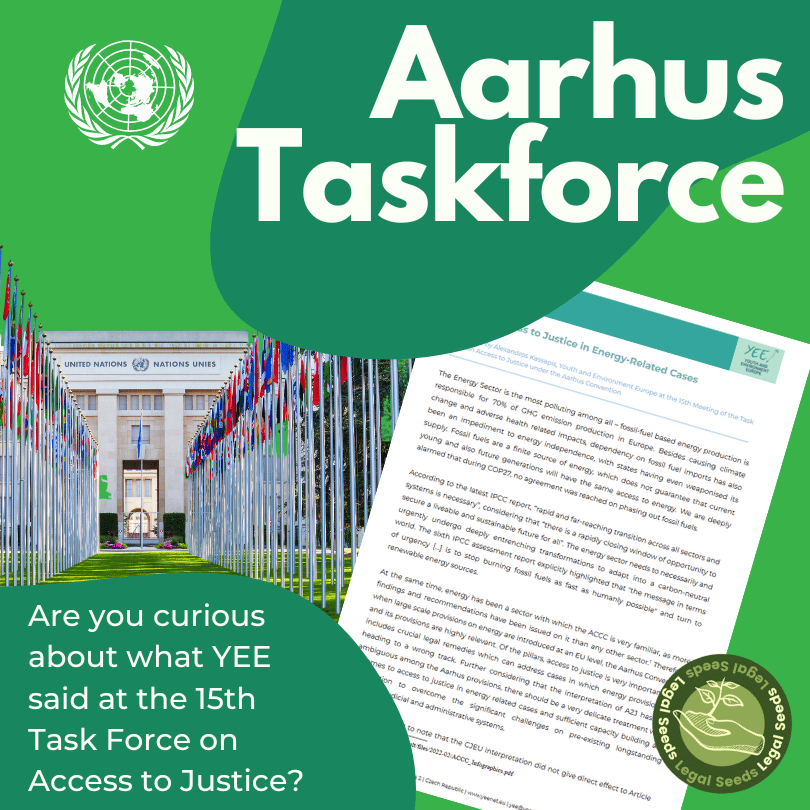
The Environmental Law Team of YEE actively participated in the 15th Task Force on Access to Justice in Geneva, sharing valuable insights.

The discussion within the EU around the Fit For 55 legislative package is at the core of the EU’s current action on
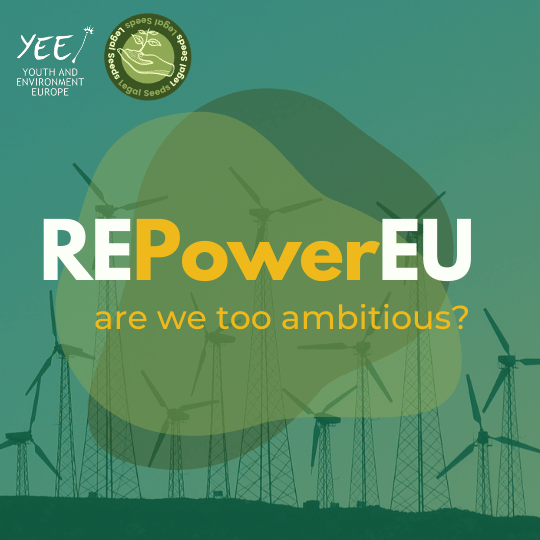
If exiting from the Russian fossil fuels, gas and coal import is a necessity, should it be then done at all costs?
More To Explore
Advocating for stronger legal protection of rivers in Europe
https://yeenet.eu/wp-content/uploads/2023/05/1-3.png 810 810 YEE https://yeenet.eu/wp-content/uploads/2018/11/logo-yee-728x1030.png YEE2023-05-18 09:44:322023-06-23 09:17:11Advocating for stronger legal protection of rivers in EuropeOur mission
 YEE aims to unite environmental youth non-profit organisations in Europe in order to enhance international cooperation, increase knowledge about the climate crisis, raise awareness of environmental problems and to strengthen participation of youth in environmental decision-making.
YEE aims to unite environmental youth non-profit organisations in Europe in order to enhance international cooperation, increase knowledge about the climate crisis, raise awareness of environmental problems and to strengthen participation of youth in environmental decision-making.
Information
Get in touch
Vinohradská 2165/48
120 00 Praha 2 – Vinohrady
Czech Republic
E-mail: yee@yeenet.eu
We are supported by
Supported by the Council of Europe through the European Youth Foundation.
Co-funded by the European Union. Views and opinions expressed are however those of the author(s) only and do not necessarily reflect those of the European Union or the European Education and Culture Executive Agency (EACEA). Neither the European Union nor EACEA can be held responsible for them.





